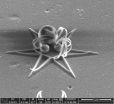(Press-News.org) For women of mixed racial or ethnic backgrounds, a new method for measuring bone health may improve the odds of correctly diagnosing their risk of osteoporosis and bone fractures, according to a UCLA-led study.
Currently, assessing osteoporosis and the risk of fractures from small accidents like falls requires a bone density scan. But because these scans don't provide other relevant fracture-related information, such as bone size and the amount of force a bone is subjected to during a fall, each patient's bone density is examined against a national database of people with the same age and race or ethnicity.
This approach, however, doesn't work for people of mixed race or ethnicity because comparison databases can't account for mixed heritage. A similar problem exists for those from smaller racial or ethnic groups for which there are not comparison databases.
"All the current ways of determining your risk for fractures require knowing your race and ethnicity correctly, and they ignore the fact that racial and ethnic groups are not homogenous," said study co-author Dr. Arun Karlamangla, a professor of medicine in the geriatrics division at the David Geffen School of Medicine at UCLA. "It also flies in the face of the current reality in Southern California, where so many people are of mixed ethnicity."
Given that osteoporosis and hip fractures are leading causes of injury in older people, alternative means of measuring risk are needed. Now, a UCLA-led team of researchers has found a way of assessing risk without knowledge of a person's race or ethnicity. The method involves combining bone mineral density measures with body size and bone size to create composite bone strength indices.
The findings are published in the October issue of the Journal of Clinical Endocrinology and Metabolism.
The researchers studied data on nearly 2,000 women in the U.S. between the ages of 42 and 53 who were of Caucasian, African American, Japanese and Chinese heritage. The data came from the Study of Women's Health Across the Nation; UCLA was one of seven sites that recruited women for the study.
Using the new composite bone strength indices, the researchers tested how the method predicted fracture risk in this group of women over a period of 10 years. They found that when they did not take into account the women's race or ethnicity, they were able to predict fracture risk using the indices just as accurately as they could using the traditional method of combining bone mineral density measures with race and ethnicity information.
"The importance of bone size to fracture risk has been recognized by engineers and radiologists for some years now," said the study's lead investigator, Dr. Shinya Ishii, who started the research while a fellow in the UCLA Division of Geriatrics and is now at the University of Tokyo. "But no one, until now, has combined bone density, which is the traditional measure of osteoporosis, with bone size and body size to get at a more uniform way of assessing osteoporosis that applies across racial lines and does away with the need to know the person's race or racial mixture."
The researchers noted that further study is needed to determine if the same strength measures will work in men. Their findings also do not show how well these measures will continue working as women age. The results of the study do, however, point toward a new approach for assessing fracture risk, they say.
###
Other researchers included Drs. Gail Greendale, Carolyn Crandall and Mei-Hua Huang of UCLA and Drs. Jane A. Cauley and Michelle E. Danielson of the University of Pittsburgh.
National Institute on Aging grants (NR004061; AG012505, AG012535, AG012531, AG012539, AG012546, AG012553, AG012554, AG012495) to SWAN; a National Institute on Aging grant (AG026463) to the Hip Strength Through the Menopausal Transition Substudy; the Veterans Affairs Greater Los Angeles Healthcare System Geriatric Research, Education and Clinical Center, and a Veterans Affairs Advanced Geriatrics Fellowship supported this research.
The UCLA Division of Geriatrics within the department of medicine at the David Geffen School of Medicine at UCLA offers comprehensive outpatient and inpatient services at several convenient locations and works closely with other UCLA programs that strive to improve and maintain the quality of life of seniors. UCLA geriatricians are specialists in managing the overall health of people age 65 and older and treating medical disorders that frequently affect the elderly, including memory loss and dementia, falls and immobility, urinary incontinence, arthritis, arthritis, high blood pressure, heart disease, osteoporosis, and
diabetes. As a result of their specialized training, UCLA geriatricians can knowledgably consider and address a broad spectrum of health-related factors — including medical, psychological and social — when treating patients.
For more news, visit the UCLA Newsroom and follow us on Twitter.
Taking race out of the equation in measuring women's risk of osteoporosis and fractures
2012-10-19
ELSE PRESS RELEASES FROM THIS DATE:
Studies target high rates of HIV medication errors among hospitalized patients
2012-10-19
San Diego, CA (October 19, 2012) – Research presented at IDWeek 2012™ concludes that despite advances in electronic medical records, mistakes are still commonly made in the prescription of antiretroviral medications for hospitalized HIV-positive patients. At the same time, a trio of studies suggests however, that electronic records in combination with increased clinical education can help to greatly decrease medical errors.
The three studies are among the significant research being discussed at the inaugural IDWeek meeting, taking place through Sunday October 21 in San ...
Directing change: How do they do it?
2012-10-19
In the long run, all organisms must adapt to survive as their surroundings do not remain constant for ever. The major difficulty with understanding adaption relates to the length of time required for experiments: evolution is by its very nature a gradual process. Fortunately, however, recent breakthroughs in experimental evolution using model organisms are providing important insights into the process. The nature of the underlying genetic changes has generally remained elusive but recent work at the Institute of Population Genetics of the University of Veterinary Medicine, ...
Young people who go out drinking start earlier and consume more and more alcohol
2012-10-19
Teenagers and university students are unaware of the negative consequences of alcohol consumption or the chances of developing an addiction as a result. In addition, they start at a younger and younger age and drink more and stronger alcohol according to a study headed by the University of Valencia.
Current drinking trends amongst Spanish youth are characterised by what is known as botellón or drinking in the streets. Researchers at Valencia's universities, Miguel Hernández de Elche and Jaume I de Castellón, have conducted a study funded by the Spanish National Drugs ...
A sharper look into the past for archaeology and climate research
2012-10-19
By using a new series of measurements of radiocarbon dates on seasonally laminated sediments from Lake Suigetsu in Japan, a more precise calibration of radiocarbon dating will be possible. In combination with an accurate count of the seasonal layered deposits in the lake, the study resulted in an unprecedented precision of the known 14C method with which it is now possible to date older objects of climate research and archeology more precisely than previously achievable. This is the result published by an international team of geoscientists led by Prof. Christopher Bronk ...
First micro-structure atlas of the human brain completed
2012-10-19
A European team of scientists have built the first atlas of white-matter microstructure in the human brain. The project's final results have the potential to change the face of neuroscience and medicine over the coming decade.
The work relied on groundbreaking MRI technology and was funded by the EU's future and emerging technologies program with a grant of 2.4 million Euros. The participants of the project, called CONNECT, were drawn from leading research centers in countries across Europe including Israel, United Kingdom, Germany, France, Denmark, Switzerland and Italy.
The ...
Sharp rise in children admitted to hospital with throat infections since 1999
2012-10-19
The number of children admitted to hospital in England for acute throat infections increased by 76 per cent between 1999 and 2010, according to new research published today in Archives of Disease in Childhood.
Acute throat infection (ATI), which includes acute tonsillitis and acute pharyngitis, is one of the most common reasons for consulting a GP. The majority of ATIs are self-limiting and can be managed at home or by the GP, but a small proportion may require hospital admission.
This study investigated admission rates for children up to age 17 with ATI alongside ...
Manufacturing complex 3-D metallic structures at nanoscale made possible
2012-10-19
VIDEO:
The video shows the assembly of a metallic three-dimensional cage, as the nanopatterned film is bent along precisely defined folding lines due to the compressive stress induced by an ion...
Click here for more information.
The fabrication of many objects, machines, and devices around us rely on the controlled deformation of metals by industrial processes such as bending, shearing, and stamping. Is this technology transferrable to nanoscale? Can we build similarly ...
Recession drives down national park visitation, new UGA study finds
2012-10-19
Athens, Ga. – A national recession doesn't just affect Americans' wallets. It also impacts their travel to national parks, a new University of Georgia study has found.
Recent visitation statistics released by the U.S. Department of Interior already noted the significant decrease in national park visitation—dropping nearly 10 million since 1998 to 278 million visitors—but this is the first study to link the drop to a bad economy. The findings could help park managers plan ahead for revenue shortfall and a decrease in visitation, particularly as the economic forecast remains ...
The art of sustainable development
2012-10-19
Montreal, October 19, 2012 – Einstein said that we can't solve problems by using the same kind of thinking used when we created them. Wise words, except few people heed them when it comes to sustainable solutions for our ailing planet. Despite decades of scientific research into everything from air pollution to species extinction, individuals are slow to act because their passions are not being ignited.
For Paul Shrivastava, the Director of the David O'Brien Centre for Sustainable Enterprise at Concordia University's John Molson School of Business (JMSB), combining science ...
Beneficial mold packaged in bioplastic
2012-10-19
This press release is available in Spanish.
Aflatoxins are highly toxic carcinogens produced by several species of Aspergillus fungi. But not all Aspergillus produce aflatoxin. Some, in fact, are considered beneficial. One such strain, dubbed K49, is now being recruited to battle these harmful Aspergillus relatives, preventing them from contaminating host crops like corn with the carcinogen.
In collaboration with University of Bologna (UB) scientists in Italy, U.S. Department of Agriculture (USDA) scientists Hamed Abbas and Bob Zablotowicz (retired) have devised a new ...


